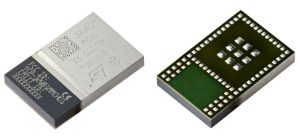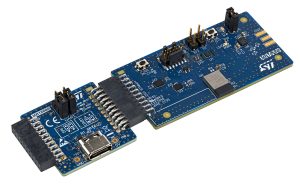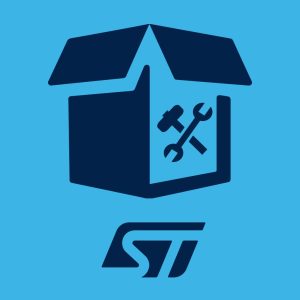The B-WB1M-WPAN1 is ST’s first hardware connectivity expansion board based on the STM32WB1MMC wireless microcontroller. It features a thermometer and an accelerometer to capture fundamental environmental data. It comes with the MB1880A USB board to power the system from a PC or a battery and provides power measurement capabilities. The board can also welcome an SMA connector for an external antenna for teams wishing to test a custom or cost-effective solution for niche applications, among other things. However, instead of just talking about our device, we wanted to share some of our expertise by pointing out the questions engineers should always ask when choosing a Bluetooth module.
Table of Contents
Why choose a module in the first place?

Engineers are familiar with modules and reference designs, but the increasing popularity of rapid prototyping and soft launches has bolstered their adoption. Instead of waiting 12 to 18 months to release the first version of a product to market, a board like the B-WB1M-WPAN1 and a module like the STM32WB1MMC can cut development times to 6 months. Selling a low-volume iteration rapidly is not only financially beneficial as teams start to see a return on investments sooner, but it can save a lot of time and money. As the first customers share feedback, the next iteration manufactured in high quantities will be more fleshed out, feature-rich, and less likely to have a breaking bug or vulnerability.
The other reason to choose a module is to outsource the RF expertise required to create a Bluetooth application. Throughout this blog post, we show the intricacies that go into designing, tuning, and developing a product that relies on a wireless stack. That knowledge often requires companies to create a team internally by acquiring talents or to outsource many aspects of the creation process. Both paths are costly and force companies to focus on something that won’t help them stand out. By choosing a module, integrators no longer need RF experts. Consequently, instead of focusing on Bluetooth LE, they can dedicate more time and creative power on the features that will make their product truly unique.
For a case study of an ST Partner that relied on a module and poured more innovation into unique functionalities, check our blog post on 221e and its two inspiring lessons from the Muse, an AI-powered STM32 sensor module.
What is inside the module?
Does the module have matching filters?
For a reference design and its module to be truly effective, it must reduce costs and accelerate development. It’s the reason why the STM32WB1MMC includes an antenna and the MLPF-WB55-01E3, 2.4 GHz matching filters. While the antenna is a common feature, nearly all competing Bluetooth modules omit matching network and harmonic filters. Consequently, integrators must purchase companion chips, which raises the overall bill of materials (BoM), adds to the PCB layout’s complexity, and takes more time to develop. Indeed, finding the right filter and tuning the antenna requires costly expertise and time. By integrating those filters into the ST Bluetooth LE module, we removed all those considerations to make the overall experience more cost-effective and time-efficient.
Does the module have multiple processors?

Engineers ought to look at the processing capabilities of the module. It sounds obvious, but it’s easy to put the issue aside when running basic blinking light demos. However, when developers finally decide to run an application destined for a medical setting or a motor control system, they run into serious performance and security issues. That’s why the STM32WB1MMC in the B-WB1M-WPAN1 adopts a dual-core approach, similar to the STM32WB5MMG that came before. Its Cortex-M0+ runs the radio while its Cortex-M4 takes care of the application. The module thus complies with some of the most stringent security requirements in medical or industrial fields that impose segregation between the application and the Bluetooth stack.
A dual-core approach is unusual in the industry since all competing Bluetooth modules are officially single-core only. Some programs don’t need such power, and we also offer single-core wireless MCUs with the STM32WB0 series for entry-level Bluetooth applications. However, products that would benefit from rapid prototyping and are subject to complex requirements often demand a dedicated processor. Consequently, unless it is already in the module, adding one onto the PCB increases costs and development times. Moreover, the ST device includes a crypto core and firmware upgrade services. A module like the STM32WB1MMC thus opens the door to new applications, and the B-WB1M-WPAN1 reference design represents a stepping stone to that new world.
How many crystals, baluns, and peripherals come with the module?
The question might seem pedantic to some, but it highlights a significant issue within the industry. All devices that integrate a Bluetooth radio and some processing power are called “modules”, but not all modules are created equal because not all “modules” house the same number of passive devices necessary for their operation. And there are no standards that prohibit a maker from calling its device a “module” even if it still needs a ton of external components to run, defeating the purpose of what the module is supposed to represent. Asking about crystals, baluns, and peripherals goes to the heart of this issue.
The STM32WB1MMC houses SMPS passive components, two crystals, baluns, one 12-bit ADC, one 16-bit four-channel advanced timer, a touch-sensing controller for a touchscreen, and more, making it one of the most comprehensive modules today. If the crystals or baluns are absent, which is often the case on competing devices, engineers must purchase them and make room for them on their PCB. It adds to the overall cost and takes longer because the additional components must be qualified, which draws out the design process. Moreover, the ST module complies with two-layer PCBs, and the size of its SiP-LGA77 package (10 mm x 6.5 mm) means it will easily fit in numerous settings.
Ask what the module can do
A Bluetooth LE module must simplify developments by taking on some of the most complex aspects of a wireless application. However, while the most comprehensive integration will look great on paper, teams that still need to invest massive amounts of time and money to write their application or meet regional standards won’t see any benefits from using a module. And some of the intricacies of wireless applications are so deep that they require intentional design choices from day one. Simply put, not knowing the requirements to release a Bluetooth LE product could kill the project. Hence, engineers must not only look inside the module but also ask what the module can do for them.
What certifications did the STM32WB module pass?
The certification issue is often overlooked, but it should be obvious that every module should pass nearly all regional requirements. Unfortunately, that isn’t always the case, which is one of the industry’s lesser-known issues. A module aims to simplify developments to make Bluetooth LE applications more accessible so even engineers with less expertise can release a product to market faster. However, a module that doesn’t pass regional certifications defeats that purpose because even if prototyping is more accessible, a maker that must still acquire tremendous expertise to pass those regional certifications will find the whole process costly and far too risky.
The STM32WB1MMC has already passed wireless certifications for the European Union (CE), the USA, Canada (FCC and ISED), and many Asian countries, such as Japan, Korea, Taiwan, China, and more. In fact, we also work with customers to get our module certified in new regions. Consequently, it means that by using a reference design like the B-WB1M-WPAN1, teams have a much simpler path to certification because the module itself is already compliant. Teams just rely on our work since the wireless stack doesn’t change.
B-WB1M-WPAN1: What demo applications already exist and are free to use?

Hardware specifications don’t tell the whole story because, as developers know all too well, they can’t reveal how hard it will be to write the application. Development times significantly increase if the documentation doesn’t properly describe the registers, timers, or low-power modes. However, it is also unfair to ask programmers to comb through thousands of pages before writing the most basic proof-of-concept. Hence, if a module is really about saving time and money, it must come with numerous demo applications that are free to use. Teams must be able to grab as much existing code as possible from the module maker to jumpstart their project.
Out of the box, the B-WB1M-WPAN1 comes with open-source demo applications found in the STM32CubeWB software package. For instance, BLE_HR_P2PServer connects the board to our smartphone application (ST BLE Toolbox) to send sensor data over Bluetooth. Developers can access all our files and implementations and reuse as much of our code as they’d like. We even have a wiki to assist them, provide a template to facilitate firmware creation and have examples to turn the LEDs on the board on and off, read and write the EEPROM, or get and send data from the sensors on the reference design. Developers thus get many of their essential needs covered and can show a proof-of-concept rapidly.




